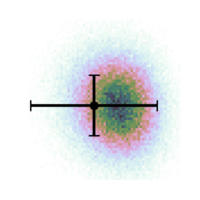Abstract
Chiral effective field theory () provides a systematic approach to describe low-energy nuclear forces. Moreover, is able to provide well-founded estimates of statistical and systematic uncertainties—although this unique advantage has not yet been fully exploited. We fill this gap by performing an optimization and statistical analysis of all the low-energy constants (LECs) up to next-to-next-to-leading order. Our optimization protocol corresponds to a simultaneous fit to scattering and bound-state observables in the pion-nucleon, nucleon-nucleon, and few-nucleon sectors, thereby utilizing the full model capabilities of . Finally, we study the effect on other observables by demonstrating forward-error-propagation methods that can easily be adopted by future works. We employ mathematical optimization and implement automatic differentiation to attain efficient and machine-precise first- and second-order derivatives of the objective function with respect to the LECs. This is also vital for the regression analysis. We use power-counting arguments to estimate the systematic uncertainty that is inherent to , and we construct chiral interactions at different orders with quantified uncertainties. Statistical error propagation is compared with Monte Carlo sampling, showing that statistical errors are, in general, small compared to systematic ones. In conclusion, we find that a simultaneous fit to different sets of data is critical to (i) identify the optimal set of LECs, (ii) capture all relevant correlations, (iii) reduce the statistical uncertainty, and (iv) attain order-by-order convergence in . Furthermore, certain systematic uncertainties in the few-nucleon sector are shown to get substantially magnified in the many-body sector, in particular when varying the cutoff in the chiral potentials. The methodology and results presented in this paper open a new frontier for uncertainty quantification in ab initio nuclear theory.
4 More- Received 18 June 2015
DOI:https://doi.org/10.1103/PhysRevX.6.011019
This article is available under the terms of the Creative Commons Attribution 3.0 License. Further distribution of this work must maintain attribution to the author(s) and the published article’s title, journal citation, and DOI.
Published by the American Physical Society
Popular Summary
Quantifying the unknown is an outstanding question in all fields of science. Reliable theoretical errors make it possible to infer the significance of a disagreement between experiment and theory, which may hint at new physics. These errors are also useful for identifying relevant new experiments. Here, we develop a framework for uncertainty quantification in ab initio nuclear theory and propagate errors to several nuclear observables.
We provide, for the first time, a common statistical regression analysis of two key frameworks in theoretical nuclear physics: ab initio many-body methods and chiral effective field theory. Our approach is computationally feasible, which allows us to incorporate systematic uncertainties and to establish a credible program for assessing the total error budget. We provide a set of mathematically optimized nuclear interaction models with known statistical properties and demonstrate methods to propagate this information to various nuclear observables. We use brute-force Monte Carlo sampling with 100,000 sampling points to demonstrate the accuracy of our error-propagation methods. We show that the theoretical uncertainties in nuclear physics very often dominate over experimental uncertainties and that systematic errors are amplified in heavier nuclei such as ; while the systematic uncertainty is found to be 5% for the binding energy of , it increases to 30% for .
We expect that our results and methodology can be readily applied to explore uncertainties in the field of ab initio nuclear theory.



